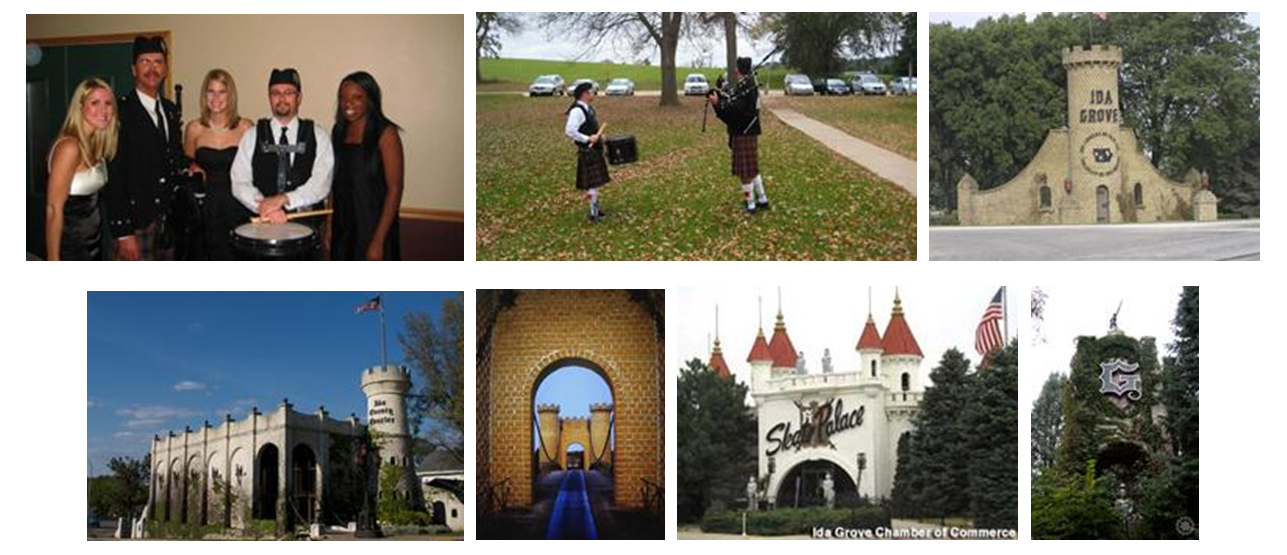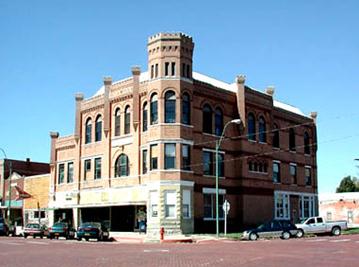
Best viewed in
Internet Explorer
PDF
Back to

Updated
07/31/2013 |
Iowa Scottish Heritage
Edited from an article by Todd Wilkinson
While nowhere as large as
their fellow immigrants from Germany or the Scandinavian countries, Iowa
has also been home to a number of Scottish immigrants, who worked as
farmers, coal miners and sheepherders across the Hawkeye State. Scottish
immigration gradually increased from the early 1850s (Iowa became a US
state in 1846) so that by 1890, some 7,000 Scottish immigrants were
recorded in the Federal Census as residing in Iowa, according to Dorothy
Schwieder’s Iowa: The Middle Land.
US Army Surgeon Samuel Muir, a native of Edinburgh, is credited with
being the first European settler at Keokuk, who left the army after
objections were raised about his Sauk Indian wife. Muir replied to his
critics, “May God forbid that a son of Caledonia should ever desert his
child or disown his clan!”
Another Iowa “river city”, Davenport, claims Dundee native James
MacKintosh as one of its founding fathers. MacKintosh, the grandson of a
veteran of the Battle of Culloden, opened a dry-goods store in the new
settlement of Davenport, as well as serving as Iowa’s first bookbinder,
land speculator and surveyor. MacKintosh was killed serving in the Union
Army during the Civil War.
Another Civil War veteran, Glaswegian Andrew McDonald, the “fighting
plumber” of Dubuque, immigrated to the United States in 1854 and soon
gained a reputation in the Mississippi River valley as a skilled
plumber. In 1861, a little under a year of becoming an American citizen,
McDonald joined the 1st Iowa Infantry and was wounded at the second
major battle of the Civil War, Wilson’s Creek, Missouri. McDonald, who
was left on the field, was taken as a prisoner by the Southerners, and
even met a fellow Scot from his days in St. Louis who was serving with
the rebels. McDonald was eventually released and returned to Iowa, where
he promptly re-enlisted and was wounded again at the Siege of Vicksburg,
Mississippi in 1863. During that time, he was granted a patent on a
screw wrench, otherwise known as the “monkey wrench”. The company he
founded, A.Y. McDonald manufacturing, is still in business today.
Settlements of Scottish immigrants could be found in Southeastern Iowa,
such as Tranquility, in Appanoose County, where a description of young
Scots at Kirk (church) in “velvet tams and kilts” was given by a fellow
expatriate and writer, Janette Stevenson Murray. The town of Scotch
Grove, in Jones County, was founded by Highlanders in the late 1830s
from the failed Red River (Canada) Colony of Lord Selkirk, and during
the 1870s a Scottish evangelist preached a sermon in Gaelic in the
Presbyterian Church of Scotch Grove, causing many an old settler to shed
a tear for their native land.
Scottish settlements in Cedar (Red Oak Grove) and Poweshiek Counties
were settled largely by immigrants from Aberdeenshire in Northeastern
Scotland, who located first in Ohio in the 1830s before moving to Iowa
in the 1840s and 50s. Unlike some immigrants, who were attracted to
settlements by professional recruiting agents, the majority of the Cedar
and Poweshiek Scots came because of communication between friends and
relatives. Marjory Harper’s Emigration from North-East Scotland
gives a very detailed account of these Iowa Scots. Other Scots from the
North-East and Aberdeen were enticed to Des Moines County in 1848 with a
description of large, cheap and fertile tracts of lands in the October
25, 1848 edition of the Aberdeen Journal.
Immigrants from Ayrshire made their way to Wolf Creek in Tama County,
where native Scot Congressman James Wilson resided. Wilson later served
as Secretary of Agriculture under Presidents McKinley, Roosevelt and
Taft. The Scots of Southeastern Iowa were known for being “clannish”;
Murray says of the Scots of Iowa that they were “bound as a homogenous
group by the three strong ties of race, religion and family.”
In Northwestern Iowa, the annual “Scotch reunion” at Ida Grove was a
very popular event that even non-Scots attempted to obtain invitations
to with attempts to “trace a great-aunt or maybe a 42nd cousin back to
the highlands.” At the reunion, there were Highland dancers and pipers,
led by local restaurant owner Major Cameron, “in highland regalia”. The
majors’ three granddaughters were continuing the tradition as late as
the 1930s, and the festivals continued into the 1950s. One descendant of
the Ida County Scots, Judith Bauer, remembers being shown how to do a
sword dance “around 2 crossed yardsticks on the kitchen floor!”

Ida Grove
also boasted a “castle” of the Royal Highlanders. Organized in 1896 in
Aurora, Nebraska, the Royal Highlanders was originally a fraternal
insurance organization. The organizations’ headquarters building in
Aurora was reportedly modeled on Balmoral Castle in Scotland.
The Royal Highlanders Building in
Aurora (below) is on the National Register of Historic Places.
The order’s purpose was “to unite for mutual benefit and fraternal
protection all white persons who are in good health, of exemplary
character, and between the ages of 16 and 65.”

Royal Highlanders Building – Aurora, NE
There
were two classes of membership, benefit and social. The ritual of the
Royal Highlanders was based on the story of William Wallace and Robert
the Bruce in their struggle for Scottish independence, and was intended
to teach “Prudence, Fidelity and Valor”. Degree teams wearing kilts and
glengarries and carrying shields and spears initiated new members into
the Order. The orders emblem even bore the heart of Robert the Bruce.
In 1930, the Order numbered some 17,000 members, both men and women,
with “extensive investments” in Nebraska farmland. Seven years later,
the Order reincorporated to become a mutual life insurance company, and
renamed itself the Lincoln Mutual Life Insurance Company in 1946.
An article from the Ida County (Iowa) Pioneer Record from 1946
documents the history of the local Royal Highlanders castle, which was
formed in 1898 with a charter membership of 35 businessmen and citizens.
In 1902, the castle organized a membership drive to “make the society
one of the largest organizations in Ida Grove.” Within a short time, 70
new members were secured, and on July 31, 1902, the “Bonnie Doon” drill
team, along with Royal Highlanders President W.E. Sharp and his wife,
came from Lincoln Nebraska to participate in the initiation ceremonies.
The next year, the Ida Grove castle began to organize its own drill
team, which was outfitted in “plaid kilties, bright shields and spears”.
The drill team then helped institute new castles in nearby towns of
Danbury, Odebolt and Holstein. The Ida Grove drill team was “ranked
among the best in the state”, according to the article, and even
attended the Royal Highlanders’ national meeting in Denver, Colorado in
September, 1909, it being the “only team from Iowa”.

The Drill Team of Ida Grove Castle No. 130, Royal Highlanders, Ida
Grove, Iowa, circa 1909.
Photo courtesy of Judith
Bauer, whose grandfather, J.E. Moorehead, is the second from the left on
the back row.
The town of Odebolt also
had a Robert Burns Society, with members made up from the Scottish
farmers of Ida and Sac Counties. A newspaper account of the Burns Supper
of 1906 lists the “bill o’ fare” for the evening, complete with piping,
songs and poems from Burns and of Scotland, Scottish Country & Highland
dancing (including a sword dance) and a party which continued on until
7.00 am - the evening’s festivities had begun at 7.00 pm! The Odebolt
Opera House was the venue for the 147th anniversary of the birth of the
ploughman poet.
Dubuque, Iowa, also celebrated the life and works of Robert Burns with a
Burns Supper near the 100th anniversary of the ploughman poet’s birth in
1859, and then later with a St. Andrew’s society, which celebrated
Burns’ birthday and St. Andrew’s Day on November 30th, as well as
providing mutual aid “to the unfortunate and poor whether or not they
were Scottish.” It is interesting to note that the society suffered a
schism in December of 1859 over the issue of temperance!
In 1936, Colonel George Dailey of the University of Iowa’s Reserve
Officer Training Corps (ROTC) program organized a pipe band to perform
at Iowa football games after seeing the band of the Black Watch while
overseas in the First World War. During the Second World War, the band
became all-female in membership due to male students serving in the
armed forces. Over the years the band has performed in parades and
festivals across Iowa, the United States and the world, and has played
for a number of US Presidents and other dignitaries. The university cut
the band’s funding in 1981, but it still operates today as a student
interest group.
Today, The Scottish Heritage Society of Iowa, with its three chapters,
continues the efforts of these earlier organizations to promote Scottish
heritage and culture.
Other Iowans of Scottish heritage include Henry Wallace, who served as
Secretary of Agriculture and Vice-President under Franklin D. Roosevelt,
as well as a presidential candidate in 1948; The noted author Norman
Maclean, who wrote a fictionalized version of his Scottish-American
family’s story in A River Runs Through It and one Marion Robert
Morrison of Winterset, who later changed his name to John Wayne. |



